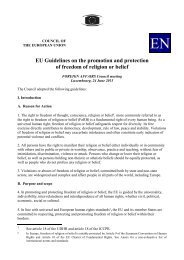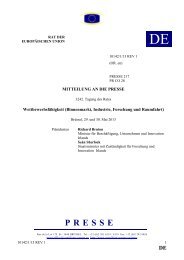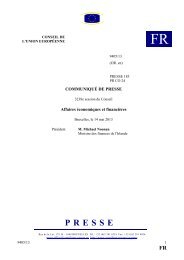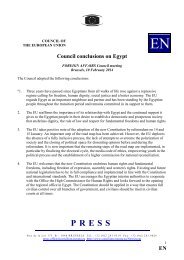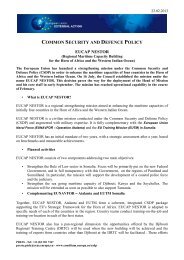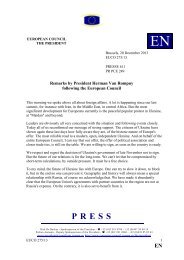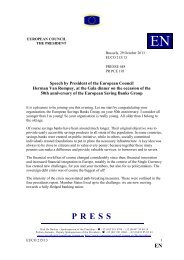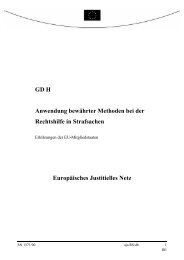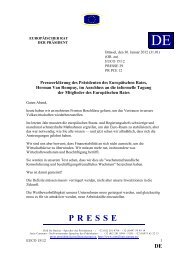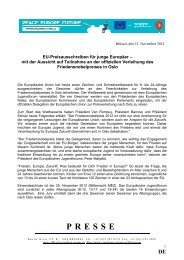14508/09 ADD 1 PL/vk 1 DG G COUNCIL OF THE ... - Europa
14508/09 ADD 1 PL/vk 1 DG G COUNCIL OF THE ... - Europa
14508/09 ADD 1 PL/vk 1 DG G COUNCIL OF THE ... - Europa
Create successful ePaper yourself
Turn your PDF publications into a flip-book with our unique Google optimized e-Paper software.
In Spain, a specific institute (Observatorio de la Imagen de las Mujeres) conducts yearly studies on<br />
advertisement and comes up with recommendations to publishers who disseminate discriminatory<br />
material on how to modify or change their campaigns in a more gender-sensitive way. In addition,<br />
several instruments have been enacted against the discriminatory portrayal of women in media, and<br />
a commission – La Comisión Asesora de la Imagen de las Mujeres en los Medios de Comunicación<br />
y la Publicidad [The Portrayal of Women in Mass Media and Advertisement] – has been set up. A<br />
Strategic plan for Gender Equality also lists five objectives in order to achieve gender equality<br />
within the field of media: the portrayal of women as active subjects, the proliferation of non-sexist<br />
pictures in mass media and advertisement, the promotion of role models, and assisting public and<br />
private media to live up to the goals listed in the gender equality law.<br />
In France, similarly, a Commission has been established to reflect on the portrayal of women in the<br />
media. Not only are women under-represented in the media, the French report notes, they are also<br />
frequently presented in a gender-stereotyped way. Legal enactments on the prohibition of<br />
advertisements with pornographic content or for services provided for the satisfaction of sexual<br />
desire, including prostitution, have been adopted in some MS (EE, LT). The training of journalists<br />
and communications experts is highlighted in many reports, including those from Hungary and<br />
Bulgaria. In the Finnish report, a training toolkit referred to as “Screening Gender” is a co-<br />
production between five public service broadcasting organisations in the Netherlands, Norway,<br />
Sweden, Finland and Germany. This kit contains tools designed to provide insight into gender and<br />
gender portrayal on television. The materials can be used in a wide range of training contexts, for<br />
example in courses on various aspects of programme making (interviewing techniques, script and<br />
scenario writing, commentary, visual grammar, and so on), in seminars to raise awareness among<br />
decision-making groups and in discussions with trainers themselves in the hope of focusing on<br />
training themes and priorities.<br />
References<br />
Council Conclusions May 2008 (Eliminating Gender Stereotypes in Society)<br />
European Commission (2008) Report on equality between women and men – 2008.<br />
http://ec.europa.eu/employment_social/publications/2008/keaj08001_en.pdf<br />
<strong>14508</strong>/<strong>09</strong> <strong>ADD</strong> 1 <strong>PL</strong>/<strong>vk</strong> 117<br />
ANNEX <strong>DG</strong> G EN



